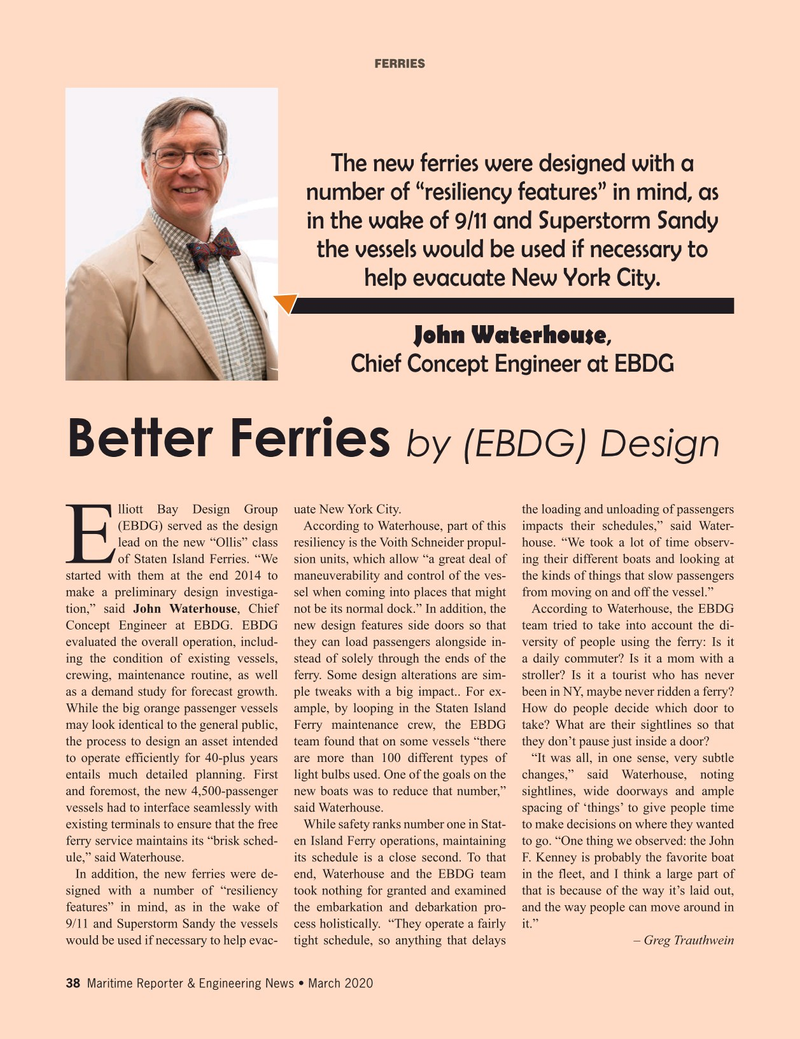
Page 38: of Maritime Reporter Magazine (March 2020)
Cruise Shipping Annual
Read this page in Pdf, Flash or Html5 edition of March 2020 Maritime Reporter Magazine
FERRIESFERRIES
The new ferries were designed with a number of “resiliency features” in mind, as in the wake of 9/11 and Superstorm Sandy the vessels would be used if necessary to help evacuate New York City.
John Waterhouse,
Chief Concept Engineer at EBDG
Better Ferries by (EBDG) Design lliott Bay Design Group uate New York City. the loading and unloading of passengers (EBDG) served as the design According to Waterhouse, part of this impacts their schedules,” said Water- lead on the new “Ollis” class resiliency is the Voith Schneider propul- house. “We took a lot of time observ-
Eof Staten Island Ferries. “We sion units, which allow “a great deal of ing their different boats and looking at started with them at the end 2014 to maneuverability and control of the ves- the kinds of things that slow passengers make a preliminary design investiga- sel when coming into places that might from moving on and off the vessel.” tion,” said John Waterhouse, Chief not be its normal dock.” In addition, the According to Waterhouse, the EBDG
Concept Engineer at EBDG. EBDG new design features side doors so that team tried to take into account the di- evaluated the overall operation, includ- they can load passengers alongside in- versity of people using the ferry: Is it ing the condition of existing vessels, stead of solely through the ends of the a daily commuter? Is it a mom with a crewing, maintenance routine, as well ferry. Some design alterations are sim- stroller? Is it a tourist who has never as a demand study for forecast growth. ple tweaks with a big impact.. For ex- been in NY, maybe never ridden a ferry?
While the big orange passenger vessels ample, by looping in the Staten Island How do people decide which door to may look identical to the general public, Ferry maintenance crew, the EBDG take? What are their sightlines so that the process to design an asset intended team found that on some vessels “there they don’t pause just inside a door?
to operate efficiently for 40-plus years are more than 100 different types of “It was all, in one sense, very subtle entails much detailed planning. First light bulbs used. One of the goals on the changes,” said Waterhouse, noting and foremost, the new 4,500-passenger new boats was to reduce that number,” sightlines, wide doorways and ample vessels had to interface seamlessly with said Waterhouse. spacing of ‘things’ to give people time existing terminals to ensure that the free While safety ranks number one in Stat- to make decisions on where they wanted ferry service maintains its “brisk sched- en Island Ferry operations, maintaining to go. “One thing we observed: the John ule,” said Waterhouse. its schedule is a close second. To that F. Kenney is probably the favorite boat
In addition, the new ferries were de- end, Waterhouse and the EBDG team in the fleet, and I think a large part of signed with a number of “resiliency took nothing for granted and examined that is because of the way it’s laid out, features” in mind, as in the wake of the embarkation and debarkation pro- and the way people can move around in 9/11 and Superstorm Sandy the vessels cess holistically. “They operate a fairly it.” would be used if necessary to help evac- tight schedule, so anything that delays – Greg Trauthwein 38 Maritime Reporter & Engineering News • March 2020
MR #3 (34-49).indd 38 3/5/2020 9:08:09 AM

 37
37

 39
39
